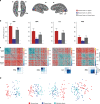Rapid and dynamic processing of face pareidolia in the human brain
- PMID: 32908146
- PMCID: PMC7481186
- DOI: 10.1038/s41467-020-18325-8
Rapid and dynamic processing of face pareidolia in the human brain
Abstract
The human brain is specialized for face processing, yet we sometimes perceive illusory faces in objects. It is unknown whether these natural errors of face detection originate from a rapid process based on visual features or from a slower, cognitive re-interpretation. Here we use a multifaceted approach to understand both the spatial distribution and temporal dynamics of illusory face representation in the brain by combining functional magnetic resonance imaging and magnetoencephalography neuroimaging data with model-based analysis. We find that the representation of illusory faces is confined to occipital-temporal face-selective visual cortex. The temporal dynamics reveal a striking evolution in how illusory faces are represented relative to human faces and matched objects. Illusory faces are initially represented more similarly to real faces than matched objects are, but within ~250 ms, the representation transforms, and they become equivalent to ordinary objects. This is consistent with the initial recruitment of a broadly-tuned face detection mechanism which privileges sensitivity over selectivity.
Conflict of interest statement
The authors declare no competing interests.
Figures







Similar articles
-
Illusory faces are more likely to be perceived as male than female.Proc Natl Acad Sci U S A. 2022 Feb 1;119(5):e2117413119. doi: 10.1073/pnas.2117413119. Proc Natl Acad Sci U S A. 2022. PMID: 35074880 Free PMC article.
-
Face cells encode object parts more than facial configuration of illusory faces.Nat Commun. 2024 Nov 14;15(1):9879. doi: 10.1038/s41467-024-54323-w. Nat Commun. 2024. PMID: 39543127 Free PMC article.
-
What does a "face cell" want?'.Prog Neurobiol. 2020 Dec;195:101880. doi: 10.1016/j.pneurobio.2020.101880. Epub 2020 Sep 9. Prog Neurobiol. 2020. PMID: 32918972 Free PMC article.
-
The Functional Neuroanatomy of Human Face Perception.Annu Rev Vis Sci. 2017 Sep 15;3:167-196. doi: 10.1146/annurev-vision-102016-061214. Epub 2017 Jul 17. Annu Rev Vis Sci. 2017. PMID: 28715955 Free PMC article. Review.
-
The two-process theory of face processing: modifications based on two decades of data from infants and adults.Neurosci Biobehav Rev. 2015 Mar;50:169-79. doi: 10.1016/j.neubiorev.2014.10.009. Epub 2014 Oct 25. Neurosci Biobehav Rev. 2015. PMID: 25454353 Review.
Cited by
-
Asymmetric stimulus representations bias visual perceptual learning.J Vis. 2024 Jan 2;24(1):10. doi: 10.1167/jov.24.1.10. J Vis. 2024. PMID: 38285454 Free PMC article.
-
The phenomenology of pareidolia in healthy subjects and patients with left- or right-hemispheric stroke.Heliyon. 2024 Feb 29;10(5):e27414. doi: 10.1016/j.heliyon.2024.e27414. eCollection 2024 Mar 15. Heliyon. 2024. PMID: 38468958 Free PMC article.
-
The cortical and subcortical correlates of face pareidolia in the macaque brain.Soc Cogn Affect Neurosci. 2022 Nov 2;17(11):965-976. doi: 10.1093/scan/nsac031. Soc Cogn Affect Neurosci. 2022. PMID: 35445247 Free PMC article.
-
Differential late-stage face processing in autism: a magnetoencephalographic study of fusiform gyrus activation.BMC Psychiatry. 2024 Dec 18;24(1):900. doi: 10.1186/s12888-024-06400-z. BMC Psychiatry. 2024. PMID: 39695511 Free PMC article.
-
Neural correlates reveal separate stages of spontaneous face perception.Commun Psychol. 2025 Aug 18;3(1):126. doi: 10.1038/s44271-025-00308-4. Commun Psychol. 2025. PMID: 40826267 Free PMC article.
References
-
- Puce A, Allison T, Gore JC, McCarthy G. Face-sensitive regions in human extrastriate cortex studied by functional MRI. J. Neurophysiol. 1995;74:1192–1199. - PubMed
Publication types
MeSH terms
Grants and funding
LinkOut - more resources
Full Text Sources

